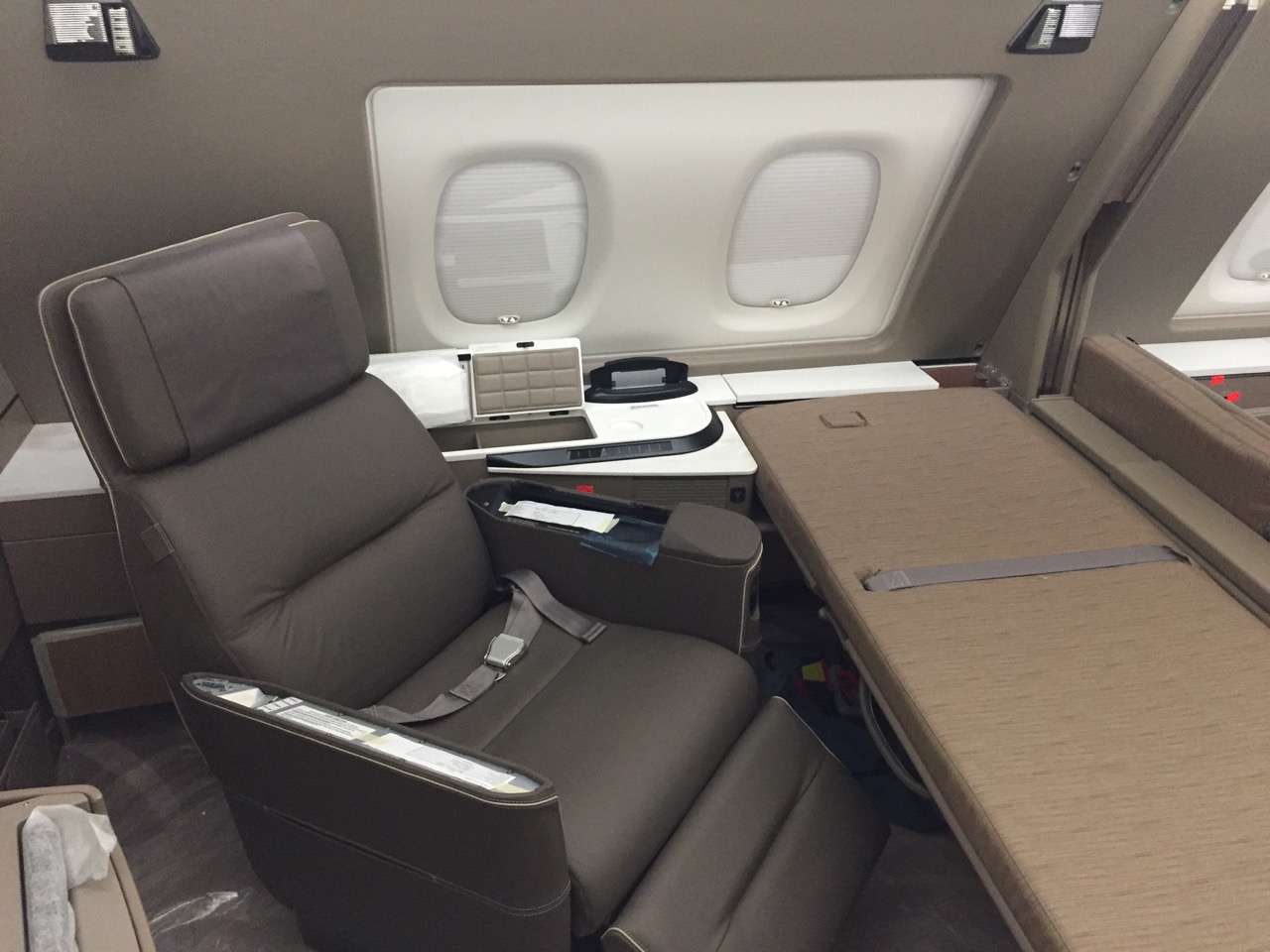In its biggest product revamp since the Airbus A380 launch in 2007, Singapore Airlines has given its newest superjumbos an all-premium upper-deck sporting six innovative first-class cabins with giant swivel armchairs.
Five new A380s being brought into the fleet will have six “Skyroom” suites on the upper deck plus 78 business class seats.
The airline officially launched new product for all four cabins using mock-ups Thursday in Singapore and will put them into service on Singapore-Sydney from December 18.
But AirlineRatings took these world exclusive pictures of the new product inside the superjumbo after being granted access to the first aircraft, 9V-SKU, at the Airbus factory in Hamburg-Finkenwerder.
The main deck will feature 44 premium economy seats in a 2-4-2 configuration at the front with 342 Economy seats in 3-4-3 array featuring a 32-inch pitch and an 18.5-inch width.
This brings the total seat count back to 471, the number with which Singapore launched the A380 a decade ago.
READ: A380 celebrates 10 years in service.
Topping the bill is the Skyroom, manufactured by Zodiac from the UK. Although spectacular, it is not as over-the-top as Etihad’s The Residence.
The first impression is a similarity to the “Flying Oval Office” on board Air Force One, the Boeing 747 used by the US president. The Skyroom is dominated by a massive swivel armchair designed by PierreJean Design Studio in France.

The 21-inch (53cm) wide electrically-controlled swivel seat can be turned around by more than 120 dgrees, is upholstered in finest Poltrona Frau leather and can recline up to 135 degrees for lounging.
Passengers get a generous 3.23 to 4 square metres (34.7 to 43 sq. ft) of floor space, with the biggest suites being 1A and F.
Each suite is shielded from the aisle by two sliding doors. These are operated manually, as opposed to the electrical doors that have been a source of prolonged malfunctions on other carriers.
They feature a 32-inch HD touchscreen monitor mounted on the wall, which can also be swivelled.
A wireless tablet is provided with integrated control functions for in-flight entertainment (IFE) and customizable mood lighting but there is a separate handset offering basic IFE control.
Passengers who want to work with their tablets can anchor them in a holder installed underneath the two windows or they can use a laptop on the fold-out table.

Another main feature is a separate fold-out flat bed measuring 76” by 27” (193cm x 68cm) which comes complete with mattress bedding, duvet and pillows.
The bedhead has a gas spring to keep the head up to watch a movie while lying down.
When Singapore Airlines introduced the A380 in 2007, its former CEO proclaimed the double suites in the middle were “bringing back the romance into flying” .
The airline didn’t quite live up to this promise because crews were instructed to not let get romantic activities out of hand.
This time again, dividers between two or even all three suites on one side of the aisle can come down, creating up to two double beds in the two forward suites 1A/2A and 1F/2F.

The two windows in each suite feature electrical blinds and each has a personal wardrobe which also provides cabin luggage stowage.
And for the first time, one of the two bathrooms, the more spacious one on the right side, has been fitted out especially for female passengers with a vanity table and stool, more mirrors and mood-lighting.
However, there is no shower like those offered on Emirates and Etihad.
Business Class travellers will still be forced to sleep diagonally, which many dislike, because of the 50-inch (127cm) seat pitch.
The new seats — designed by JPA Design and manufactured by JAMCO — feature a kind of noise-suppressing cocoon to shield the passenger.

The fixed enclosures are lower than before, addressing customer complaints, and the bed is lowered into position electrically rather than manually.
Bed length has remained the same at 78” (198cm), two inches longer than in the first class suites, but narrow at the foot end. The bed space can be enlarged by a fold-out bridge.
The width of the leather seats is a generous 25 inches (63.5cm) and, for the first time, the divider between the two middle seats can be put down fully to enable partners to travel together. Once fully down it creates almost a double bed.
There are smaller new features, such as storage ideas and a fixed side table.
Preferred seats are the bulkhead middle seats 11D/F, 91D/F and 96D/F as they have by far the biggest foot space and don’t require passengers to sleep diagonally.
Premium economy is at the front end of the main deck and features customized seats by German manufacturer ZIM, which also provides Lufthansa’s premium economy seats.
Seat pitch is a generous 38 inches (96.5cm) , width 19.5 inches (49.5cm) and every seat includes foot- and leg rests plus a spacious pocket able to store a laptop.
All seats in all classes now offer touchscreens, with the ones in premium economy measuring 13.3” (33.8cm) in diameter, while those in economy are 11.1 inches (28cm).
The 343 Economy seats are manufactured by German market leader Recaro.
The two best choices in economy, particularly given there is no extra charge, are the window seats 71A/K. These seats do not have a seat in front of them, despite being in the second row behind the bulkhead.
All 471 seats on Singapore’s new A380 now feature plug ins to recharge electronic devices and also USB ports, plus contactless card readers to pay for purchases.
























